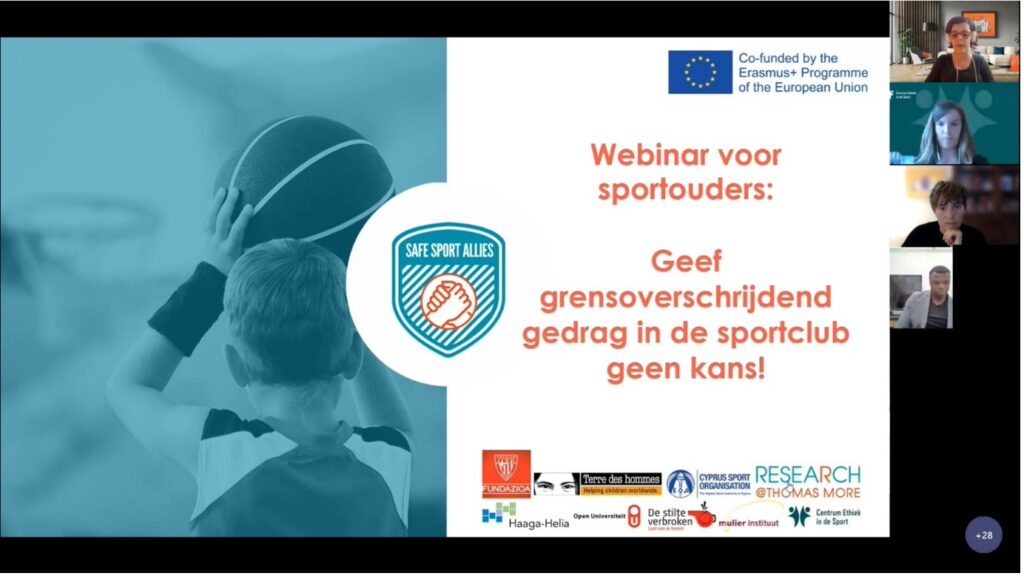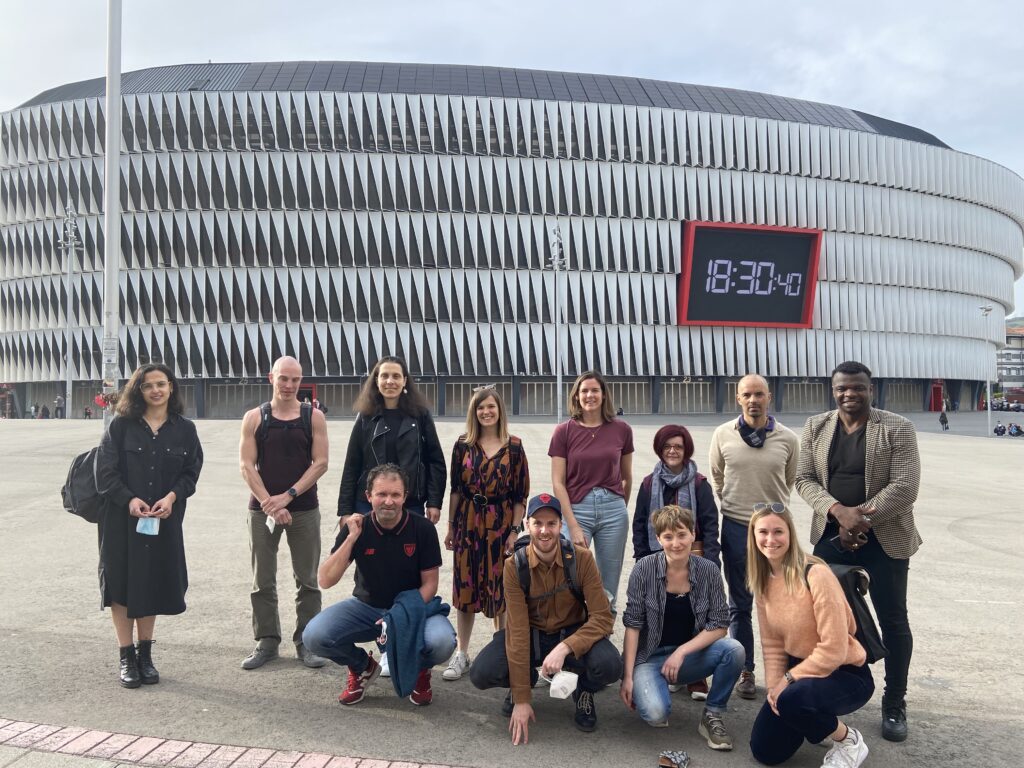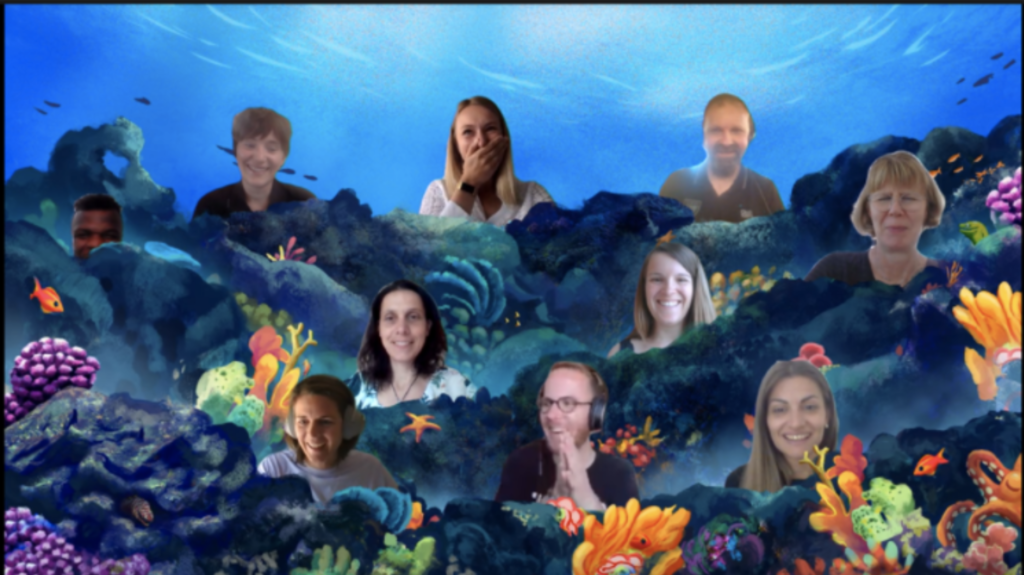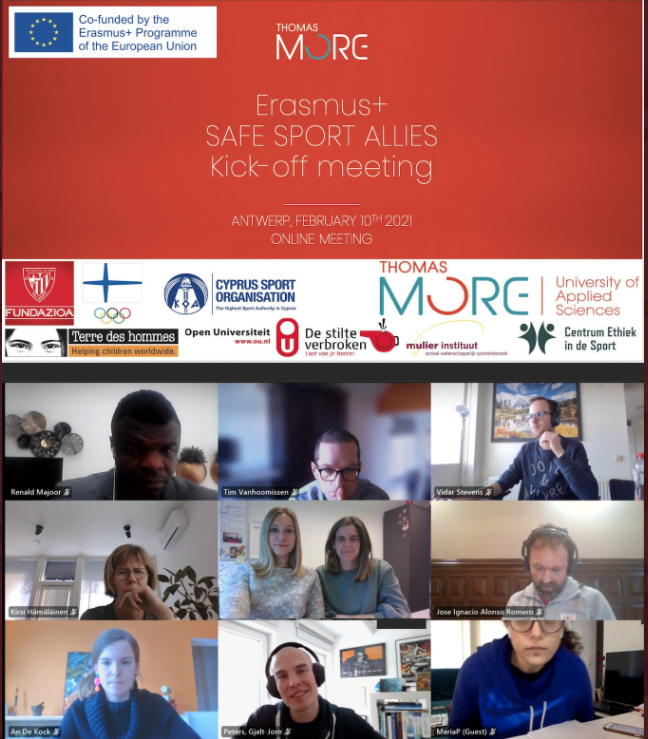Transnational partner meeting 4: Output development meeting
At the end of September ’22, all Safe Sport Allies partners gathered in Ghent (Belgium) for the fourth international project meeting. In the course of three days, several work meetings and discussions among the partners took place. Using the preliminary results of our interventions implemented in Flanders and the Netherlands, we brainstormed on the development of educational materials to support sport stakeholders in preventing harassment and abuse in local sport clubs. At the time of the meeting, our project interventions reached over 90 local sport clubs. A total of 99 young athletes in 10 clubs participated in our Safe Sport Allies Athlete Workshop, as well as 106 youth sport coaches from 14 clubs. We hosted a webinar for sport parents and supported 33 local sport club managers in self-assessing their safeguarding policies. The preliminary results of these interventions were presented and discussed in our consortium.
All of these findings formed the ideal starting point to brainstorm on the development of the Safe Sport Allies educational materials. In small working groups, we conceptualized initial ideas around the Safe Sport Allies handbook, infographics for sport club members, discussion cards for youth sport coaches and an animation video about positive bystanding behaviors.
Realizing that this project too will reach its end eventually, the colleague from Mulier Institute took us on the Safe Sport Allies sustainability journey. Possible steps to support local sport clubs to sustainably implement bystander education were discussed and all partners raised important issues with regard to capacity, long-term implementation, situational contexts and challenges.
Overall, this project meeting once again consisted of busy, but exciting days. Between the meetings we also had the opportunity to visit the beautiful city of Ghent and made sure we also spent some time being physically active. Once back home, all Safe Sport Allies partners have now started working on the development of the educational materials. We aim to have the proofs of concepts ready early 2023, so that the production can start in the Spring. We will keep you updated regarding this development process and the final products!
Best wishes from the Safe Sport Allies team
En wat zou jij doen? Thomas More leert jeugdtrainers omgaan met grensoverschrijdend gedrag
Ook in de sportwereld is grensoverschrijdend gedrag alom tegenwoordig. Recent onderzoek heeft dit opnieuw bevestigd en zowel sportfederaties als sportclubs hebben een preventie- en reactiebeleid uitgewerkt. Tegelijk is er duidelijk een nood aan informatie en vorming. Om hieraan tegemoet te komen heeft een onderzoeksteam onder leiding van Tine Vertommen een vormingsprogramma uitgewerkt voor jeugdtrainers.
De cijfers liegen er niet om
Uit recente onderzoeken (1) blijkt dat 86% van de sporters heeft minstens één ervaring met grensoverschrijdend gedrag in de sport waarvan
4 op de 5 van de jonge sporters een vorm van psychologische grensoverschrijdend gedrag heeft ervaren
1 op 2 een vorm van fysiek grensoverschrijdend gedrag
1 op 4 een vorm van seksueel grensoverschrijdend gedrag
Waarover gaat het dan precies?
Heel concreet betekent dit:
dat jonge sporters geconfronteerd werden met geroddel of vernedering door mede-sporters (38%);
dat zij te maken krijgen met overmatige kritiek van medesporters (33%);
dat zij verplicht werden om mee te trainen ondanks een blessure en tegen medische negatief advies in door de trainer (19%);
dat er al eens een object naar hem/haar gegooid werd door de trainer (25%).
Kortom: elke club, elke trainer wordt vroeg of laat geconfronteerd met een jonge sporter die grensoverschrijdend gedrag ervaart. Het herkennen van en gepast reageren op grensoverschrijdend gedrag is echter niet vanzelfsprekend. En al helemaal niet als het gaat over seksueel grensoverschrijdend gedrag.
Iedereen aan boord
Sinds de eerste studies over (seksueel) grensoverschrijdend gedrag in de sport zet de sportsector meer en meer in op een kwaliteits-, preventie-, en reactiebeleid. Zo zijn er richtlijnen ontstaan om bijvoorbeeld een gedragscode op te stellen of om een vertrouwenspersoon aan te stellen. Desondanks blijkt dat er bij trainers, begeleiders, bestuurders en andere medewerkers van sportclubs een grote onzekerheid blijft bestaan over het herkennen van signalen en hoe er gepast op te reageren. Binnen het project ‘Iedereen aan Boord – samen werken aan een veilig sportklimaat’ hebben onderzoekers van Thomas More daarom een vormingstraject uitgewerkt specifiek voor jeugdtrainers. Als centrale figuur in de sportclub speelt de trainer immers een belangrijke rol in het creëren van een veilig sportklimaat. “Trainers besteden veel tijd met hun sporters en zij hebben vaak ook een goede band met hun sporter. Zij zijn soms getuige van situaties die niet oké zijn en zij kunnen als omstander wel degelijk een verschil maken. Belangrijk is dat zij alert zijn, de situatie opmerken en hierop reageren,” verduidelijkt onderzoeker Helena Verhelle.
En wat zou jij doen?
Om de bepalende factoren van omstandersgedrag (Wat maakt dat iemand wel of juist niet reageert?) te identificeren, organiseerde het team de online bevraging ‘En wat zou jij doen?’. 1422 Vlaamse trainers namen hieraan deel. Het merendeel (90%) gaf aan in het voorafgaande jaar geen seksueel grensoverschrijdend gedrag te hebben opgemerkt of waargenomen. 127 respondenten gaven aan dat zij in het afgelopen jaar wel getuige waren van seksueel grensoverschrijdend gedrag, maar niet altijd tussenkwamen. “Ingrijpen is ook niet gemakkelijk en best oncomfortabel,” geeft Tine Vertommen toe. Bovendien zijn er vormen van grensoverschrijdend gedrag, die niet door iedereen als dusdanig ervaren worden. Denk aan een seksueel getinte uitlating, een schuine mop, een flirterige opmerking… De een tilt daar niet zwaar aan, terwijl de ander het als kwetsend ervaart.
Herkennen en gepast reageren
In het vormingstraject wordt daarom eerst en vooral ingegaan op het herkennen van grensoverschrijdend gedrag in het algemeen en seksueel grensoverschrijdend gedrag in het bijzonder. Probleemgedrag benoemen, het bespreekbaar en binnen de club een gedragscode hanteren: het zijn belangrijke stappen. Actie ondernemen is een ander paar mouwen. Want wat doe je als je bijvoorbeeld een collega over de schreef ziet gaan? Of als een jonge sporter je in vertrouwen neemt over seksueel grensoverschrijdend gedrag? Tijdens de workshop worden concrete tips (2) aangereikt. Zoals luisteren zonder te oordelen als iemand zijn verhaal komt doen en het ook niet minimaliseren. Of nog: geen geheimhouding beloven, wel discretie. Als je zelf getuige bent van een incident is het belangrijk om de ernst van de situatie goed in te schatten. Het vlaggensysteem van Sensoa is hierbij een hulp: geel voor een licht grensoverschrijdende situatie, rood voor ernstige en zwart voor zéér ernstige situaties. Naargelang de situatie kan je de pleger aanspreken op zijn gedrag, het gedrag begrenzen of zelfs verbieden. In alle gevallen is het aangewezen om je te ontfermen over het slachtoffer, steun en hulp te bieden. In zeer ernstige situaties is dit laatste zelfs prioritair. Maar minstens even belangrijk is het om zo’n situatie te melden bij de Aanspreekpersoon Integriteit (API) of vertrouwenspersoon van de club.
Groter vertrouwen
Om het effect van dit vormingstraject te kunnen meten, werd deze uitgetest. Hiervoor werden zeven begeleiders opgeleid, die het traject in negen Vlaamse pilootclubs in de atletiek, basketbal, hockey, zwemmen en voetbal hebben gegeven aan 56 deelnemers. Helena Verhelle: “Ik denk dat we voorzichtig mogen zeggen dat zo’n workshop het omstandersgedrag van jeugdtrainers positief beïnvloed. De resultaten geven weer dat trainers voldoende vertrouwen hebben om op te treden als omstander. Ze voelen zich comfortabeler in hun rol en gaan doortastender reageren. Bovendien gaan ze het zelf belangrijk vinden dat zij die rol van omstander kunnen opnemen. En ze gaan beseffen dat zij als trainer een impact hebben om de situatie verbeteren. We willen wel benadrukken dat deze resultaten voortkomen uit een kleine groep sportclubs. Er is dus zeker nog meer onderzoek nodig om deze bevindingen te bevestigen.”
Safe Sport Allies
Het onderzoeksteam van Thomas More zet zijn expertise op vlak van grensoverschrijdend gedrag blijvend in om een veilige sportomgeving te creëren voor iedereen. In het vervolgproject Safe Sport Allies (3) wordt daarom het volledige spectrum van grensoverschrijdend gedrag – psychisch, fysiek en seksueel – onder de loep genomen. De focus ligt bovendien niet alleen op trainers maar ook op het clubbestuur, ouders en sporters zelf.
In het kader van dit Europees gefinancierde onderzoek heeft het team onder meer een vragenlijst uitgewerkt die het clubbestuur kan gebruiken als een vorm van zelfscan om het beleid binnen hun sportclub onder de loep te nemen. De online tutorial over het opzetten van een preventiebeleid is een extra hulpmiddel en zet hen verder op weg. Voor ouders van jonge sporters is een webinar uitgewerkt waarin wordt ingegaan op het herkennen van een goede sportclub, wat je als ouder kan doen om mee te werken aan een veilig sportklimaat en wat je an doen als er iets misloopt. Deze webinar werd vorig seizoen al een keer georganiseerd en wordt op 19 oktober herhaald.
Webinar ouders (mei 2022)
Op dinsdag 31 mei 2022 organiseerden we onze allereerste Safe Sport Allies webinar “Geef grensoverschrijdend gedrag in de sportclub geen kans” voor ouders van jonge sporters. De webinar werd gegeven door An De Kock (ICES, BE) en Suzanne Scholtus (De Stilte Verbroken, NL). In totaal namen zo’n 45 sportouders (zowel uit BE en NL) deel . Tijdens de webinar lichten we het belang toe van een gezonde en veilige sportomgeving en schotelden we enkele mythes voor over grensoverschrijdend gedrag in de sport. Daarna gingen we dieper in op de rol die ouders spelen in de sportclub en hoe zij er mee voor kunnen zorgen dat hun kinderen op een veilige manier aan sport doen. Ook gaven we informatie mee over waar ouders terecht kunnen met vragen, bezorgdheden of klachten. Er werd niet enkel informatie meegegeven aan de ouders, maar er werd ook gebruik gemaakt van interactieve polls en er kwamen ook enkele getuigenissen van sporters en ouders die grensoverschrijdend gedrag meemaakten aan bod.
Omdat ons Safe Sport Allies aanbod verlengd wordt tot eind oktober 2022 plannen we een nieuwe editie van onze webinar voor ouders in de maand september of oktober. Blijf ons zeker volgen via facebook of op onze website!

Transnational partner meeting 3: Intervention update meeting (April 2022
At the end of March ’22, all Safe Sport Allies partners gathered in Bilbao (Spain) for the third international project meeting. Although the project started more than a year ago and a lot of work was already being done (see previous posts), this was the very first time that this international group could physically meet each other. During one and a half day, several meetings were held with the aim of updating all partners on the project progress, and to exchange input and feedback on the content of the Safe Sport Allies interventions.
In small groups, the partners studied and discussed each part of the project in detail. They discussed the first findings of the pilot study and, where necessary, proposed adjustments. Among other things, the scripts for the workshops for the athletes and coaches were discussed, as well as the scripts for the webinars for club managers and sport parents. In addition, an initial brainstorm was organised regarding the content and logistics of the future Safe Sport Allies national workshops, which will take place in each of the participating countries in 2023. Each national project leader will organize this workshop according to the target audience and specific context.
Overall, this project meeting consisted of busy, but exciting days. Between the meetings we also had the opportunity to visit the beautiful stadium and museum of Athletic Club Bilbao. José Ignacio Alonso Romero, safeguarding officer of Athletic Club, also presented the club’s ATERPE program through which they support young athletes from the club and dozens of other clubs in the region.
Once back home, all Safe Sport Allies partners will start working with the input and feedback, and all parts of the intervention will be finalized and prepared for the actual field work in sports clubs in Flanders (Belgium) and the Netherlands. There is still a lot of work to be done, but everyone is excited to move forward. Fortunately, in the meantime the sports clubs are running at full speed and showing interest and enthusiasm to participate in the Safe Sport Allies project.
Is your club also interested or do you know a club that would be interested in our free workshops for athletes, coaches, parents and club managers? Surf to our registration form, leave your details and we will contact you!
Greetings,
The Safe Sport Allies team

Launch of Work Package 3 ‘Intervention and Protocol Design’ (Dec 2021)
During the last couple of months we shifted to a next phase in the Safe Sport Allies project. In a previous step we completed the knowledge documents (factsheet with country comparison, literature review and factsheet with survivors’ suggestions) regarding bystander programs in and outside sport. The obtained knowledge enabled and guided us to start developing the intervention script and materials, and the measurement toolkit which will be used to investigate the effectiveness of the intervention.
Currently, we are finalizing all the scripts, materials, and measurements. Our bystander intervention focuses on four actors (who all can be seen as bystanders) from local sport clubs in Flanders (Belgium) and the Netherlands: (1) young athletes (12-14 year old), (2) coaches, (3) the club management, and (4) parents of young athletes. When a sport club is participating in the study, each of these actors will be provided with a tailor-made training. For example, young athletes can participate in a face to face training (60 to 90 minutes), whereas coaches can participate in a face to face training (or online if required because of the pandemic; +- 135 minutes) and 3 online boostersessions. The complete intervention is approved by the Societal and Social Ethics Committee of the University of Leuven.
In the upcoming phase, we will be piloting the intervention for young athletes and coaches. This will allow us to make, if needed, necessary changes to the final intervention (i.e. scripts, materials, measurements) of these two actors. We aim to start with the actual field work (Work Package 4) from February 2022 onwards.

Results of Work Package 2 ‘Knowledge Development’
The compelling character of the testimonials by people affects by sexual, psychological, and physical violence in youth sport, as well as the available prevalence estimates have urged European policy makers and sport organisations at local, national, and international level to take action. While at first only some international and national sport organisations took the lead, by now, many more organisations in Europe have initiated child protection and safeguarding policies. Slowly, the world of sport is waking up on the issue, raising the taboo and willing to challenge a sporting culture that is conducive for violence and exploitation of children.
The Safe Sport Allies project aims to combat psychological, physical, and sexual violence, and proactively safeguard children in sport, through the development, implementation, monitoring and evaluation of a bystander intervention that will allow athletes, parents, coaches, and managers to adequately react to child abuse in sport. The bystander intervention will increase awareness, knowledge, skills, self-efficacy, and capacity of relevant actors in youth sport clubs to challenge harmful social norms and behaviours as well as promoting positive, healthy ones. By longitudinally testing the effectiveness on behaviour change of these actors, this project also delivers a sound methodology to test interventions aiming at safeguarding children in sport organisations.
The first step of the Safe Sport Allies project was to develop a knowledge document regarding bystander programs in and outside sport (including practices from all partner countries). In doing so, every partner in the project has contributed by doing a mapping study on national safeguarding initiatives in and outside sport, with specific attention for bystander interventions. Furthermore, the Mulier Institute conducted a literature review about factors that foster bystander intervention programmes. In addition, interviews, focus groups and group conversations with bystanders and survivors of abuse in sports have enriched our understanding of how children in sport organizations can best be safeguarded. The three outputs, which together form the knowledge document (factsheet with country comparison, literature review and factsheet with survivors’ suggestions), are presented in the ‘publication section’ of this website.
11th of June – First Safe Sport Allies Multiplier Event
On the 11th of June we organized the first multiplier event of the Safe Sport Allies Project. We are grateful for the positive responses and insights of all fifteen multiplier partners on the project.
We will incorporate all the insights, precautions, tips and tricks we gained during the event.
Thanks again to all multiplier partners for your participation! We are looking forward to June 2021 to meet you all in Antwerp for the 2nd Multiplier Event.
10th of June – Transnational Partner Meeting
Looking at these pictures, you wouldn’t say we’re a violence prevention group, but we are! Second #SafeSportAllies partner meeting. Wrapping up the ‘knowledge development phase’ and ready to prepare our bystander intervention in local sport clubs.


Kick-Off meeting
Bit different than planned, but even online, the positive vibes were going strong! Thanks to all our partners for kicking off our #SafeSportAllies project today.

Project description
Safeguarding children from violence and abuse in local sport clubs
Too many children experience sexual, psychological or physical violence during their participation in organized sport. Following painful disclosures and prevalence studies that can no longer be overlooked, child protection and safeguarding practices are being developed and implemented throughout European sport. However, to date, these initiatives lack solid evidence of impact. Monitoring and evaluation data are barely existing, which compromises an evaluation of their effectiveness. Moreover, grassroots sport clubs seldom have designated staff to adequately implement the required procedures and practices.
One of the most devastating factors in too many stories of violence against young athletes is the phenomenon of bystanding. Even though child abuse is in most cases a repeating event, signs of abuse are still often overlooked, or bystanders decide not to act upon them. Passive bystanding contributes to the continuation of children’s suffering and protects the abuser. In order to stimulate prosocial bystanding, it is crucial to educate sports club stakeholders on when and how to intervene in case of a report, disclosure, or concern.
In this European collaborative partnership, we aim to take an evidence-based approach in setting up, implementing, and evaluating bystander interventions. A multidisciplinary group of sport administrators, survivors, safeguarding practitioners and researchers will develop an educational program for athletes, coaches and parents, and a policy roadmap for club managers. In order to test the effectiveness, a longitudinal evaluation study with an intervention and control group will be conducted in two countries.
This project will provide useful insights in developing, implementing, and evaluating an intervention program to stimulate prosocial bystander behavior and safeguard children in grassroots sport clubs. By organizing national workshops and a European webinar, the educational materials will be disseminated into the wider EU sport community.
